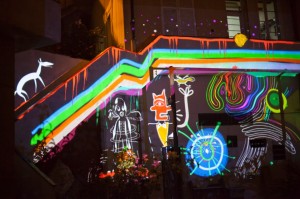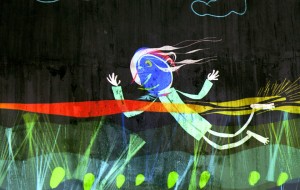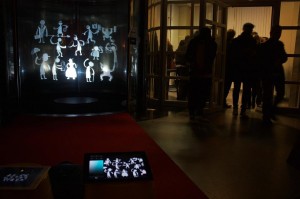For the last month or so I’ve been immersed in learning the new live drawing iPad app Tagtool. It was created by OMAi, a small startup here in Austria (Tulln/Vienna) and was released about 3 months ago after a few years of development, first as a DIYÂ live-drawing kit for projection artists, and now as a fully native touchscreen application. Anyone who’s spent time with me in the last 6 weeks or so has gotten an earful about it (and probably a demo) because I really think the app is fantastic. In fact I’ll go so far as to claim that the gestural interface they’ve developed for the app is THE future of digital creative interfaces, as native to the touchscreen as the mouse and the keyboard are to the touchless-screen-based world. If it’s any indication (and I think it is), i now find myself automatically trying to use Tagtool gestures when I use other iPad applications. They’ve become ingrained quickly in my muscle memory because they are so effortlessly natural to the way touchscreens function. And as far as I know, no other drawing app is doing that.
The ostensible purpose of Tagtool (which it succeeds at fantastically) is to enable collaborative multi-artist projection 2D art and animation sessions (including simple projection mapping), with a kind of “musical instrument” philosophy that prioritizes immediacy and continual forward motion over meticulous back-tracking and self-correction. In other words, it’s a drawing app that exists as much in time as it does in space. In fact, OMAi have explained the app’s creative philosophy in their Tagtool Manifesto.
Inevitably, this approach turns off some digital artists, accustomed as they are to the ease of undoing and changing things with a few button clicks. But much like live music making, if you accept the premise that some things can be adjusted (a guitar string can be tuned) and others simply have to be worked with (an improvisational melody can only move forward) then you will adapt to the kinds of performative focus that Tagtool represents. I can certainly say from experience that kids really love it – they have no preconceptions about how digital art should work, and they learn the interface almost instantly.
The other focus of the Tagtool philosophy is seamless realtime collaboration. Multiple artists, each with their own iPad, can collaborate on the same projection session, switching focus between creating new elements, and responding to or changing other artists’ elements on-screen, thus improvising a group performance. Here the comparison is equally like music and puppetry. The “actors” in the scene can be moved on stage or off, and in realtime the app allows multiple puppeteers to seamlessly trade strings.
So I think there are multiple important things going on here, each of special interest to different creative practitioners. One is this notion of “performative drawing software”, one is “realtime visual collaboration” and the third is this fantastic two-handed drawing interface. That’s quite a killer combo in my eyes, and that’s why I’ve latched on and have excitedly shown this app to everyone with eyeballs. The fourth important factor is that they are a small, smart, creative startup in a rural corner of semi-Eastern Europe making something of (what I consider to be) international creative significance, and they’re just downright great guys. I know I shouldn’t consider this wildly improbable but… yeah. It’s magical.
Anyhow enough yapping, here’s a silly little video that I made with gnu at their sprawling 14th century fortress-cum-farmhouse festooned with street art on the shores of the Danube, in lovely Tulln.


